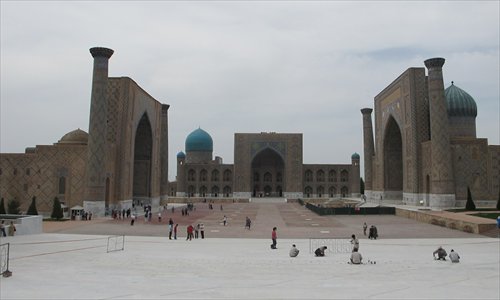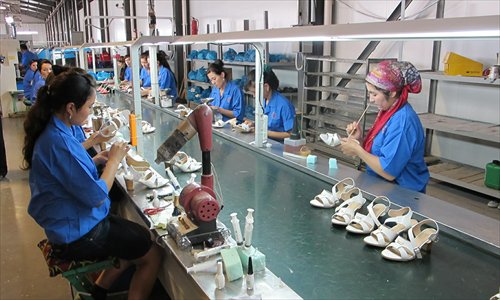Silk Road economic belt concept pushes trade, investment between China, Central Asia

The Registan Square in Samarkand, Uzbekistan. Photo: Wang Wenwen/GT
The ancient Silk Road trading route tends to conjure up images of camel rides across sand dunes dotted with date palms, but the modern reality consists more of highways and customs posts.
For Huang Jie, 49, the Silk Road is not a mere piece of colorful history, but a key element of her livelihood. She runs a shop in the Yalian Chinese market in central Almaty, Kazakhstan's largest city. She is expecting goods imported from China's Xinjiang Uyghur Autonomous Region via the Horgos hub, a highway connecting China and Kazakhstan.
Huang, who migrated to Kazakhstan from her hometown Xinjiang, has been doing business there for more than 20 years. The large shop that she runs sells China-made sauces, kitchen utensils and other daily necessities to local residents, who make up 99 percent of her customers.
Huang is just one of the thousands of businesspeople from China who live in Kazakhstan and trade between the two neighboring countries.
Around 2,000 years ago, Horgos served as part of the Silk Road's trade routes, through which caravans of camels carried goods such as silk, jewelry and handicrafts across Eurasia, linking the continent's east and west with Central Asia as the intermediate waypoint.
China's initiatives
During Chinese President Xi Jinping's trip to Kazakhstan in September last year, he envisioned the notion of the "Silk Road economic belt," which aims to revitalize the ancient Silk Road and to boost cooperation with countries, particularly those in Central Asia.
According to a map outlined by the Xinhua News Agency, the land-based "Silk Road economic belt" will begin in Xi'an in Northwest China before stretching west through Lanzhou of Gansu Province and Urumqi and Horgos of Xinjiang. Then it will run southwest from Central Asia to northern Iran before swinging west through Iraq, Syria, and Turkey. From there it will cross the Bosporus Strait and head northwest through Europe.
But this concept has generated a flurry of media commentary, and not all of it has been positive. Many have expressed cynicism and fears of Chinese economic and geopolitical domination, as China reemerges as the major influential power in the region.
Farooq Yousaf, a Pakistan-based expert with a focus on Central Asia, believes that the project is too ambitious to be implemented in the short run, and that too many obstacles remain.
"It covers a number of states whose present and future seem fragile. Besides, it doesn't say how it will cope with regional trade bodies such as the EU, as their interests will intersect. Last but not least, China will have to face local hurdles such as from Xinjiang and global ones in the form of international actors that are anti-China," Yousaf told the Global Times.

Local workers make shoes in a factory in the Peng Sheng Industrial Park in Uzbekistan. Photo: Wang Wenwen/GT
Economic cooperation
In Uzbekistan, there are roads and railways under construction to better aid future cooperation with China and countries of the Middle East. In Kazakhstan, the government has been making efforts to expand the transport capacity between Xinjiang's Alataw Pass and Kazakhstan, and rebuilding roads from the center of Kazakhstan to the Russian border.
According to Plamen Dimitrov, a visiting fellow at the L.N.Gumilyov Eurasian National University in Kazakhstan, Central Asian countries would rather cooperate with China or other countries than with each other for several reasons.
"First of all, the profiles of their economies are similar. Can they produce consumer goods like China? No. And Kazakhstan cannot export oil or gas to Turkmenistan because Turkmenistan also has oil and gas. Second, there are political obstacles. They do not have the best inter-neighbor relations. For example, Kyrgyzstan has border disputes with Uzbekistan. Also, there is competition between Kazakhstan and Uzbekistan over leadership in the Central Asian region," Dimitrov told the Global Times.
A model example of cooperation is the Peng Sheng Industrial Park jointly established by Wenzhou Jinsheng Trade Co and Uzbek business partners in 2009 in Sirdaryo Province, which is located in the center of Uzbekistan and 70 kilometers from its capital Tashkent.
The industrial park hosts seven factories producing ceramic tiles, leather shoes, mobile phones, taps, casings and pet food. Eighty percent of the employees are Uzbek locals, and the rest are Chinese at managerial levels.
According to Wang Xinghe, the general manager of the industrial park, the ceramic tiles are mainly sold to the Central Asian market, leather products are exported to China to be further processed, and the tap factory exports its goods to the Turkish market and is planning to expand its business to the European market, which "enlivens all of the Silk Road routes."
And most importantly, Wang told the Global Times that given the rising domestic labor costs in recent years, the Silk Road could help China save a lot of money, and that expanding with China's input could boost the country's economic transformation.
Justyna Szczudlik-Tatar, an expert at the Polish Institute of International Affairs, noted in her policy paper that as the current export- and FDI-driven economic model is performing less effectively for China, China needs to find new export markets in order to preserve stability inside China and promote relations with its neighborhood.
Currency concerns
For Chinese businesses in some Central Asian countries, currency conversion also remains a problem.
Yu Hongkai, a Uzbekistan-based sales director responsible for the Central Asian market of Shandong Kerui Holding Group Co, a private company that provides petroleum equipment, told the Global Times that the biggest obstacle to doing business in Uzbekistan is the government's tight control over foreign exchanges.
"It is a headache when you have made money here but you cannot take it back to China. The efficiency of the banks is low, and the entire country is short of dollars. If a company sends money to China, which is always a large sum, it will have to suffer huge losses," Yu told the Global Times.
Yavuz Onay, Vice Chairman of the Turkish Chinese Chamber of Commerce and Industry, based in Istanbul, told the Global Times that he is positive about China's role in the economic belt and would like to see more cooperation between the two countries through Central Asia. At the same time, he also wants to see a bigger role for the Renminbi, which has been going global.
"Now the world's economy is dominated by the dollar and euro. Perhaps we need a third currency - Renminbi, which will encourage competition among different currencies and do good for the world's economy," said Onay.
There have already been discussions about making the Renminbi the primary currency in Central Asia among Chinese scholars, as cooperation between China and Central Asia has deepened in recent years.
However, while some expect a bigger role for China, others are wary of the "China threat" rhetoric. Yang Cheng, an associate professor at the School of Advanced International and Area Studies, East China Normal University, warns that stressing the role of the Renminbi is not a feasible approach.
"Currency is a dimension to measure the regional influence of a country. There has been a lot of speculation about China's influence in the Central Asian region and the region is quite sensitive about the matter. On the one hand, the basic option for Central Asian countries is to find a balance between the existing powers in the region. This would mean allowing the yuan, dollar and ruble to compete and make the best of the situation. On the other hand, Central Asia has traditionally been Russia's domain. For years Russia has been trying to integrate this as a Soviet space, and one means of which is to expand the regional influence of the ruble. Therefore, making the Renminbi the primary currency in the region must take into consideration the feelings of Central Asian countries and Russia," said Yang. "If China is eager to do it, it will be taken as a challenge by partners. China should be aware of this when promoting the economic belt," Yang said.
Natural evolution
Despite various concerns raised by scholars and pundits about China's "ambitions," the notion of the "Silk Road economic belt" has won support from the countries involved. Kazakh President Nursultan Nazarbayev has reportedly said Kazakhstan would actively support the construction of the economic belt. Kurbanov Daniyar, Uzbekistan's Ambassador to China, said at an international symposium organized by the China Institute of International Studies in March that the economic belt is a logical follow up to the common aspirations of China and Central Asian countries for further economic cooperation.
Regardless of whether the countries concerned are actively supporting it, trade has already flourished along the proposed belt, as can be observed in these countries, and the belt still remains a concept rather than a policy that can be implemented through details.
Chinese scholars have been working on possible measures to promote the economic belt, such as bilateral agreements between China and individual countries and a regional free trade zone.
But since it is China that raised the concept, it should avoid talking too much about it itself, Yang Cheng said.
"Other countries care about what the economic belt can bring to themselves. China should get to know what these countries and their people really expect from China as a big power," he said.
Newspaper headline: Reviving the way